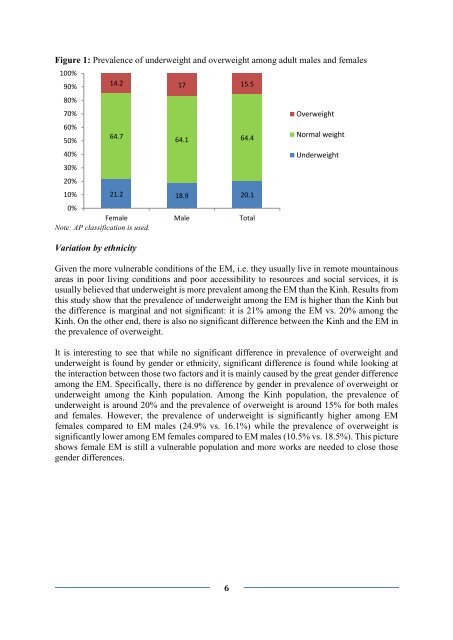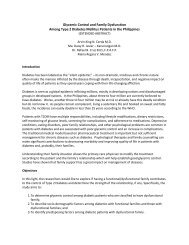Prevalence and variation of underweight and overweight among ...
Prevalence and variation of underweight and overweight among ...
Prevalence and variation of underweight and overweight among ...
You also want an ePaper? Increase the reach of your titles
YUMPU automatically turns print PDFs into web optimized ePapers that Google loves.
Figure 1: <strong>Prevalence</strong> <strong>of</strong> <strong>underweight</strong> <strong>and</strong> <strong>overweight</strong> <strong>among</strong> adult males <strong>and</strong> females100%90%80%70%60%50%40%30%20%10%64.70%Female Male TotalNote: AP classification is used.Variation by ethnicity14.2 17 15.564.1 64.421.2 18.9 20.1OverweightNormal weightUnderweightGiven the more vulnerable conditions <strong>of</strong> the EM, i.e. they usually live in remote mountainousareas in poor living conditions <strong>and</strong> poor accessibility to resources <strong>and</strong> social services, it isusually believed that <strong>underweight</strong> is more prevalent <strong>among</strong> the EM than the Kinh. Results fromthis study show that the prevalence <strong>of</strong> <strong>underweight</strong> <strong>among</strong> the EM is higher than the Kinh butthe difference is marginal <strong>and</strong> not significant: it is 21% <strong>among</strong> the EM vs. 20% <strong>among</strong> theKinh. On the other end, there is also no significant difference between the Kinh <strong>and</strong> the EM inthe prevalence <strong>of</strong> <strong>overweight</strong>.It is interesting to see that while no significant difference in prevalence <strong>of</strong> <strong>overweight</strong> <strong>and</strong><strong>underweight</strong> is found by gender or ethnicity, significant difference is found while looking atthe interaction between those two factors <strong>and</strong> it is mainly caused by the great gender difference<strong>among</strong> the EM. Specifically, there is no difference by gender in prevalence <strong>of</strong> <strong>overweight</strong> or<strong>underweight</strong> <strong>among</strong> the Kinh population. Among the Kinh population, the prevalence <strong>of</strong><strong>underweight</strong> is around 20% <strong>and</strong> the prevalence <strong>of</strong> <strong>overweight</strong> is around 15% for both males<strong>and</strong> females. However, the prevalence <strong>of</strong> <strong>underweight</strong> is significantly higher <strong>among</strong> EMfemales compared to EM males (24.9% vs. 16.1%) while the prevalence <strong>of</strong> <strong>overweight</strong> issignificantly lower <strong>among</strong> EM females compared to EM males (10.5% vs. 18.5%). This pictureshows female EM is still a vulnerable population <strong>and</strong> more works are needed to close thosegender differences.6



